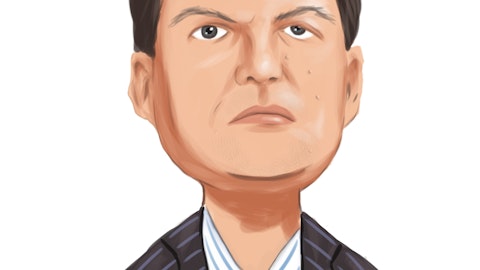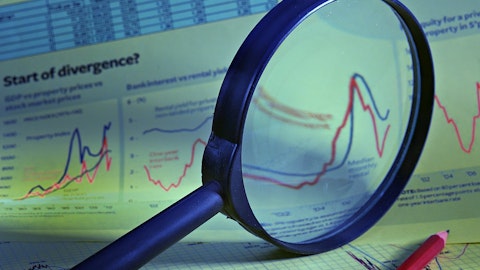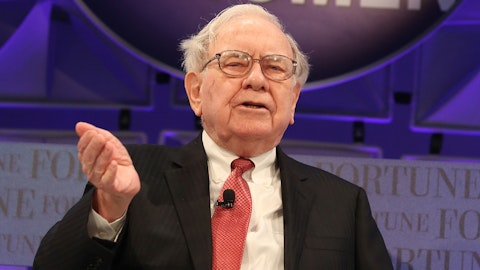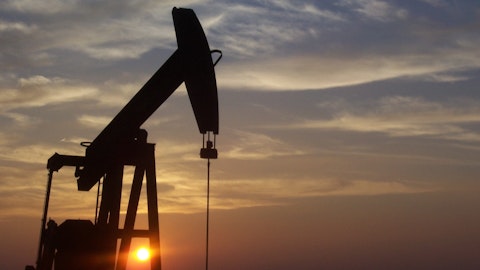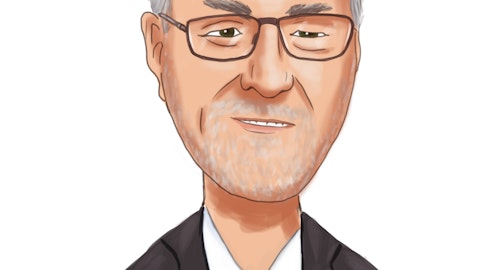Helmerich & Payne, Inc. (NYSE:HP) Q4 2022 Earnings Call Transcript November 17, 2022
Helmerich & Payne, Inc. reports earnings inline with expectations. Reported EPS is $0.45 EPS, expectations were $0.45.
Operator: Good day, everyone, and welcome to today’s Helmerich & Payne Fiscal Fourth Quarter Earnings Call. At this time, all participants are in a listen-only mode. Later you will have the opportunity to ask questions during the question-and-answer session. I will be sending by should you need any assistance. And it is now my pleasure to turn today’s call over to Vice President of Investor Relations, Dave Wilson, please go ahead.
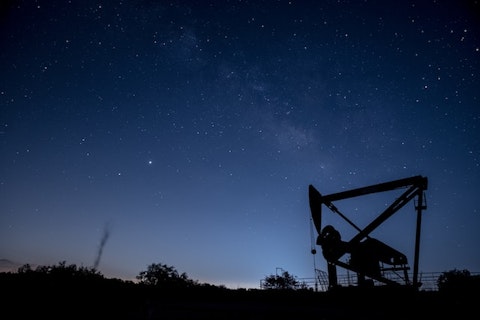
Photo by Jared Evans on Unsplash
Dave Wilson: Thank you, Ashley, and welcome everyone to Helmerich & Payne’s conference call and webcast for the fourth quarter and fiscal year ended 2022. With us today are John Lindsay, President and CEO; and Mark Smith, Senior Vice President and CFO. John and Mark will be sharing some comments with us, after which we’ll open the call for questions. Before we begin our prepared remarks, I’ll remind everyone that this call will include forward-looking statements as defined under the Securities Laws. Such statements are based upon current information and management’s expectations as of this date and are not guarantees of future performance. Forward-looking statements involve certain risks, uncertainties and assumptions that are difficult to predict.
As such, our actual outcomes and results could differ materially. You can learn more about these risks in our annual report on Form 10-K, our quarterly reports on Form 10-Q and our other SEC filings. You should not place undue reliance on forward-looking statements, and we undertake no obligation to publicly update these forward-looking statements. We will also be making reference to certain non-GAAP financial measures such as segment, direct margins, and other operating statistics. You’ll find the GAAP reconciliation comments and calculations in yesterday’s press release. With that said, I’ll turn the call over to John Lindsay.
John Lindsay: Thank you, Dave, and good morning, everyone. I appreciate you joining us on our 2022 fiscal year end call. We’re pleased with our fourth quarter results and are optimistic about fiscal 2023. My primary things will focus on 3 areas this morning: North America Solutions pricing and margin cycle dynamics; H&P’s international opportunities; and our technology and sustainability investments. Our financial results improved substantially quarter-over-quarter as pricing increases, and better contract economics took hold across more of our FlexRig fleet. You may recall from our previous earnings calls this year, we made the point that our rig pricing needed to improve to a level that provides at least a 50% gross margin in order to achieve returns above our cost of capital.
I’m encouraged to report that our leading-edge pricing levels are now delivering margins in line with that goal. These are results not seen since the 2012, 2014 upcycle. Strong demand from customers coupled with rollovers of term contracts, should help drive average pricing higher across our active fleet and we believe there is significant momentum heading into fiscal 2023. We plan to maintain a posture of fiscal discipline in our North America Solutions segment and continue to move our average rig margins toward leading-edge pricing and margins. As such, we expect our financial results for the first fiscal quarter of 2023 to follow the improving trend of the past 2 fiscal quarters. We are also seeing continued demand for our technology solutions.
These solutions have and are anticipated to continue to add significant value for our customers. Many of our technology products and automation solutions are in high demand and are quickly becoming integral parts of the bid process, daily operational workflows and performance-based contracts. These solutions are contributing to H&P becoming the leading drilling solutions provider to many of our customers. Our technology team is creating an exciting future where digital technology will be the key determinant that drives customer value by enabling safer, more efficient and reliable operations. In short, our people are actively caring culture, our rigs, technology and commercial models will continue to differentiate H&P’s drilling solutions. Let me now turn to some observations on pricing and margins in our asset intensive business.
A key metric to be mindful of here is how much of our customer demand can be satisfied by contractual churn rather than by introducing additional supply into the market. We’ve talked about churn on previous calls. In this instance, we define churn as the situation where a rig is released from one customer and then re-contracted to another customer within an economically reasonable amount of time, enabling the rig to maintain a high level of activity. During the past 2 quarters, the demand for FlexRig has primarily been satisfied with readily available hot rigs. This allows us to postpone the investment of bringing a rig out of stack and thus exercise capital discipline. Here’s an example. In our fourth fiscal quarter, only 1 rig was reactivated out of stack in the quarter.
That same quarter, however, we experienced a churn of 14 rigs, and in the third fiscal quarter our churn was 18 rigs with 3 rigs reactivated. The takeaway is that the majority of customer demand in the past couple of quarters has been satisfied by rig churn, not rig reactivations. The reasons for higher or lower churn in the market have typically revolved around acquisitions, efficiency gains, acreage, budgets and supply chain delays. We are seeing churn from both large and small customers, and we suspect this is happening across the market. Currently, while much of the rig demand is being satisfied through churn, there appears to be enough incremental demand growth to reactivate some rigs out of stack as we move into 2023. We mentioned in our October press release announcing our supplemental shareholder return plan and fiscal 2023 CapEx budget that we would reactivate up to 16 rigs.
This will allow us to attain a maximum of 192 active FlexRigs for fiscal 2023, sometime during the second fiscal quarter. Regarding these planned reactivations, we are requiring term contracts of at least 2 years. As of today, roughly two-thirds are already committed with the majority of those rigs going to large, publicly traded E&Ps. As in prior years, we expect most of these 2023 rig adds to begin working toward the front half of our fiscal year. Having said this, we also still anticipate contractual churn throughout the year similar to what we experienced in 2022, possibly averaging around 15 rigs per quarter. Understanding these pricing dynamics, holding the line on capital discipline, and not chasing market share is something we believe is crucial to creating a healthy and sustainable company over the longer term.
This discipline extends to not only exercising prudence and fiscal restraint, but also careful consideration to putting capital to work in order to take advantage of longer-term growth opportunities. Having this mindset is enabling improved returns for our stakeholders including investors who are returning to invest in the energy space. Moving to our International Solutions segment, the company plans to deploy capital and preparation for more substantial growth in the future. We’re seeing opportunities to bid in areas of existing operations as well as in countries that would be new to H&P. Most of the opportunities are where unconventional drilling is in its very early stages, such as in the Middle East. The other opportunity here is the scarcity of digital solutions being applied in many key energy producing regions around the globe.
We believe our proven drilling solutions and technologies can provide significant value to national oil companies by jumpstarting the unconventional learning curve. As we look to the future, we believe our international business is an important avenue of growth and serves as a potential outlet for some of our currently idle super-spec rigs in the U.S. International growth also adds diversification to the company’s revenue streams over the long-term, and this current allocation of investment capital plays a pivotal role in the execution of our strategy. Shifting to the energy transition, we continue to further our strategy of deploying capital and expertise to companies playing an active role in the transition. As an example, our investments in geothermal are helping to develop an alternative low carbon 24/7 power source.
We are providing FlexRigs and our digital technology solutions to enable enhanced geothermal systems and closed loop drilling concepts. Notably, we have made encouraging progress in field trials with 2 of our geothermal investees, Fervo and Eavor. Regarding Fervo, this past September, we completed drilling their enhanced geothermal system pilot project in Nevada, which involves the first 2 horizontal geothermal wells ever drilled in the U.S. And we are currently drilling Eavor’s closed loop pilot project in New Mexico. Once complete, we expect this closed loop project to be the deepest and hottest directional geothermal well in history. Our strategic alliances with Fervo and Eavor, and all of our investees has put us firmly on the path toward the advent of next generation geothermal, as H&P takes the lead in unconventional geothermal drilling.
We are hopeful that these pilot projects lead to scalable low carbon geothermal developments utilizing FlexRig solutions. Our second sustainability report will be published soon, and we will continue to provide the transparency that is important to our stakeholders. Our team is working hard to continue to raise the bar as a responsible leader in the energy services sector. In summary, we enter fiscal 2023 with momentum and increased confidence that our initiatives in our North America Solutions segment have gained traction and are delivering positive financial results. We are also excited about the longer term prospects and opportunities before us, particularly in our International Solutions segments. Finally, we believe, we’ve achieved a balanced and responsive capital return methodology with our supplemental shareholder return plan.
These actions align with the company’s long history of financial stewardship by increasing the company’s financial returns through long-term investment in the business, and increasing cash returns to shareholders through the augmentation of our longstanding dividend commitment. For over the past 10 years, we have returned $2.4 billion in dividends. In closing, during my 35-year career, I have never witnessed a higher level of alignment and communication with our customers, resulting in greater transparency and value delivered. As a service and solutions company, the successes H&P has achieved and plans to achieve would not be possible without our devoted, customer focused and hardworking employee base, which I’m proud to say continues to set the standard for our industry.
And now, I’ll turn the conference call over to Mark.
See also 25 Most Visited Countries in the World and 25 Most Technologically Advanced Countries in the World.
Mark Smith: Thanks, John. Today, I will review our fiscal fourth quarter and full year 2022 operating results; provide guidance for the first quarter and full fiscal year 2023 is appropriate and comment on our financial position. Let me start with highlights for the recently completed fourth quarter and fiscal year ended September 30, 2022, the company generated quarterly revenues of $631 million versus $550 million in the previous quarter. The increase in revenue relates to continued price increases in the quarter for the North America Solutions fleet. Correspondingly, total direct operating costs incurred were $412 million for the fourth quarter versus $377 million for the previous quarter. The sequential increase was driven by some structural inflation, but to a greater extent maintenance and supply expensive volatility that we typically see in North America Solutions quarter-to-quarter, which ended up being on the higher end of the range this quarter.
General and administrative expenses totaled $47 million for the fourth quarter, and $182 million for fiscal 2022, which is in line with our expectations. In other income expense was a loss of approximately $9 million, which was primarily driven by a lump sum distribution for participants exiting our pension plan. Our Q4 effective income tax rate was approximately 38%, which is higher than the statutory rate of 21% primarily because of foreign income taxes and permanent book to tax differences. As we crossed the line to become profitable towards the end of the fiscal year, we accrued additional U.S. cash taxes in fiscal 2022, of which approximately $45 million remains that we plan to pay with the extended filing of our tax return in January of 2023.
To summarize fourth quarter results, H&P earned a profit of $0.42 per diluted share versus $0.16 in the previous quarter. Earnings per share were negatively impacted by a net $0.03 loss per share of select items, which was primarily made up of the aforementioned contingent item. Absent the select items adjusted diluted earnings per share was $0.45 in the fourth fiscal quarter, compared with an adjusted $0.27 during the third fiscal quarter. Capital expenditures for fiscal 2022 totaled $251 million, which was within the range we established in November of 2021. For John’s previous comments on market churn, we limited our rig reactivations mid-fiscal-year and keeping with our strategy of capital discipline. H&P generated $234 million in operating cash flow during fiscal 2022.
As we discussed last quarter, our cash flow generation fully funded CapEx and our base dividend in Q3. And this quarter, we were able to do the same and even added some cash to the balance sheet as well. We will discuss accretive FY 2023 cash generation later in these remarks. Turning to our 3 segments beginning with the North America Solutions segment, we averaged 176 contracted rigs during the fourth quarter, up from an average of 174 rigs in fiscal Q3. We exited the fourth fiscal quarter with 176 contracted rigs as expected. Revenues were sequentially higher by $66 million due to pricing increases for our rigs in the spot market and continued repricing of term rollovers. Segment direct margin was $204 million just below the top end of our July guidance and sequentially higher than the third fiscal quarter by $36 million.
In addition, reactivation costs of $7.5 million were incurred during Q4 compared to $6.5 million in the prior quarter. The Q4 reactivation costs are primarily related to the rigs being prepared for deployment in the first few months of fiscal 2023. Total segment per day expenses, excluding recommissioning cost and excluding reimbursables increased to 16,453 in the fourth quarter from 15,490 per day in the third quarter. This was above our expectation due primarily to normal maintenance of supplies expense volatility, as well as inflation that I mentioned previously. Looking ahead to the first quarter of fiscal 2023 for North America Solutions, as of today’s call, we have 180 rigs contracted, and we expect to end our first fiscal quarter with between 181 and 186 working rigs with expectations for a few additional as in early January, and with line of sight for up to 192 rigs by the end of fiscal Q2.
Our current revenue backlog from our North America Solutions fleet is roughly at $864 million for rigs under term contract. As of today, approximately two-thirds of the U.S. active fleet is on a term contract, or increase in term value of approximately $235 million from June 30 to September 30 is due to: one, the reactivation is in the first 2023 fiscal quarter requiring term contracts; and two, term extensions as well as some performance contracts for strategic customers. However, from now through March 31, we have about 65 rigs rolling off of term contracts, with almost half rolling off on March 31. As a result of these more legacy type term rigs rolling off a tailwind is created for the average pricing level of rigs remaining under term contracts.
Accordingly, in an oversimplified example, if all of these rigs rolled to the spot market, we would expect the average pricing of our remaining term rigs to benefit roughly 1,500 per day over each of the next couple of quarters as lower price term rigs were simply removed from the average. For reference, we expect the average revenue per day for our term rigs in the first fiscal quarter to be about $30,000 per day. We still expect the percentage of U.S. fleet on term to be between 50% and 60% by the end of fiscal 2023. In the North America Solutions segment, we expect direct margins in fiscal Q1 to range between $250 million to $270 million inclusive of the effect of about $8.5 million in reactivation costs. As of the recent start of fiscal year 2023, we increased field labor related rates to respond to market conditions and assist in talent retention and attraction.
As a reminder, our contracts are structured to pass through such labor related costs increases over a 5% threshold. Therefore, significant labor increases are largely margin neutral at the time of adoption due to contractual protections. Also, approximately 70% to 75% of our daily costs are labor related and these recent increases are approximately $650 per day. Our direct margin guidance is inclusive of our expectations for labor and materials inflation in the first fiscal quarter. Regarding our International Solutions segment, as expected International Solutions business activity increased by 3 rigs to exit the quarter with 12 rigs; having added 2 in Argentina and late in the quarter 1 in Colombia. As we look toward the first quarter of fiscal 2023 for International, we expect to add another rig in Argentina and benefit from a full quarter of the recently added rig in Colombia.
In our October press release, we mentioned upgrading 5 Argentina rigs to super-spec. These upgrades are performed in Argentina using local currency and are intended to meet ongoing customer demand for unconventional drilling. We will have 9 of 12 FlexRig fleet is working by December 31 and plan to upgrade the 5 that are not super-spec by the end of this fiscal year. We also expect to continue to incur more expenses as we further develop our Middle East hub inclusive of preparation to export super-spec FlexRigs that will be targeted at reasonable unconventional drilling operations. Aside from any foreign exchange impacts, we expect to have between $7 million to $10 million direct margin contribution in the first quarter. While it will not contribute to activity until the fourth fiscal quarter of 2023, you may have read reports of our recent investment in rig contract with Tamboran Resources in Australia.
Australia was on our long-term planning horizon for opportunities around the burgeoning unconventional plays globally. And we look forward to adding value by bringing your unconventional expertise and experience to this long-term project. Our customer has key acreage in an emerging unconventional gas play in the Beetaloo Basin. And there are no current super-spec rigs in Australia that are suitable for such drilling. H&P’s first rig in Australia is being scheduled to ship during the first half of the year. And if our customers successful with their delineation work, we’re hopeful that this will be a new region for international growth. Turning to our Offshore Gulf of Mexico segment, we have 4 of our 7 offshore rig platform rigs contracted, offshore generated direct margin of $9 million during the quarter, which was within our guided range.
As we look toward the first quarter of fiscal 2023 for the offshore segment, we expected it will generate between $8 million to $10 million of direct margin. Now, let me look forward to the first fiscal quarter and full fiscal year 2023 for certain consolidated and corporate items. As we increase our rig count, capital expenditures for the full fiscal 2023 year are expected to range between $425 million to $475 million. This capital outlay is comprised of 3 domestic buckets plus international and corporate spend. As discussed on the July call, our North America segment CapEx has 3 buckets, maintenance reactivation and conversion. Our bucket of maintenance CapEx cost is anticipated to push above the high end of our historical range of $750,000 to $1 million per active rig.
The fiscal 2023 range is expected to be between $1.1 million and $1.3 million per active rig. As mentioned in our October press release, the reasons for this are twofold. One is due to the reduced spending during the pandemic years when the company judiciously preserved capital spending by utilizing component equipment from idle rigs. Now we’re making up for those capital spending deferments. The second reason is the current inflationary environment and supply chain challenges. The second bucket for our North America segment is new for 2023 and includes rig specific reactivation CapEx that is required for the plan to redeployment of up to 16 rigs that have been stacked for some time, much of the spend will be incurred to overhaul componentry that we optimally utilize during the protracted downturn.
Such discreet reactivation CapEx is anticipated to range from $1 million to $4 million for each of the 16 rig reactivations planned in the first half of fiscal 2023 depending on the unique rigs particular componentry involved. The final bucket for NAS is the conversion bucket, which relates to the continuation of our walking rig conversion program. We plan to convert 1 rig a month for the first 6 months of fiscal 2023 for reactivation in the U.S. market. As a reminder, our skidding to walking conversions are approximately $7 million per rig. The International segment also has 3 areas of spend concentration: first, we are converting 6 stacked rigs in the U.S. from skidding to walking in the second half of the fiscal year and also incurring recommissioning CapEx for those 6 conversions, which will be exported; second, as mentioned earlier, we’re upgrading 5 total rigs in Argentina the super-spec; and third, maintenance CapEx for the International and Offshore segments are collectively expected to be $1 million to $2 million per active rig.
Finally, corporate capital investments are expected to be about 10% of our fiscal 2023 CapEx. Two-thirds of this is information technology related, including hardware lifecycle replacements, enhanced data capabilities, and further improvements to our infrastructure, communications and cybersecurity. Depreciation for fiscal 2023 is expected to be approximately $400 million. A few overarching comments and capital expenditures are in order; first, CapEx is up year-over-year, as we are investing to maintain our U.S. fleet with modest growth this year, as well as investing in international growth for future year margin generation as well as geographic margin diversity. It is important to note that after our planned 16 U.S. rig reactivations and our planned 6 international rig exports, we will have 32 remaining stacked super-spec FlexRigs located in the U.S. for future growth domestically or internationally in upcoming years.
Second, if you exclude the pandemic years of 2020 and 2021 capital intensity, which we measure as CapEx as a percentage of revenue should be among the lowest it has been in the last 10 years in fiscal 2023 This reduced capital intensity results in return and cash flow generation which I will comment on more in a few minutes. Finally, like fiscal 2022, we are committed to our CapEx guidance for fiscal 2023 barring any unexpected investment opportunities in the international markets. Our general and administrative expenses for the full fiscal 2023 year are expected to be approximately $195 million, which is up from the year recently completed, which had an average of 163 rigs working. While this annual G&A spend, there’s just under the $50 million per quarter run rate we had going into the pandemic, when we had approximately 195 rigs working.
We’re expecting to operate about the same number of rigs in an inflationary environment. And at the same time, we’re building capabilities to support future international growth. In essence, we’re doing a bit more with a little less for support costs. Specifically, we expect about $50 million of expense in Q1 with the remainder spread proportionally over the final 3 quarters. Our investment and research and development remains largely focused on solutions important to our customers such as drilling automation, wellbore quality and power management. We anticipate R&D expenditures to be approximately $28 million in fiscal 2023. As a result of our return to profitability, we are once again becoming a U.S. quarterly estimated taxpayer. We are expecting an effective income tax rate range of 23% to 28% with the variance above U.S. statutory rate of 21% driven by state and foreign taxes.
Based upon estimated fiscal 2023 operating results and CapEx, we are projecting a consolidated cash tax range of $190 million to $240 million, of which $45 million relates to fiscal 2022 taxes to be paid in fiscal 2023, resulting in a cash tax range of $145 million to $195 million related to fiscal 2023 activity. Of note, we currently estimate that the impact of our deferred tax liability roll off for fiscal 2023 is less than $10 million. It should be noted these ranges do not include approximately $28 million in federal tax receivables on September 30, 2022, of which about $25 million were subsequently collected in October after the fiscal year end. Now, looking at our financial position. Helmerich & Payne had cash and short-term investments of approximately $350 million as September 30, 2022 versus $333 million at June 30.
Including availability under revolving credit facility our liquidity remains at approximately $1.1 billion. We again expect changes in the components of working capital to reduce cash in fiscal 2023, as was the case in fiscal 2022. Whenever revenue increases, as we expect with pricing uplifts across the fiscal year, rising receivables create a use of cash. Fiscal Q1 is expected to experience lower cash flow from operations in the following quarters due to the planned rig reactivations and ongoing price increases. Earlier, I mentioned the cash flow generation expected for fiscal 2023. As John mentioned, moving through fiscal 2023, our returns as measured in ROIC should be back in line with level seen in 2014 and earlier. These levels are expected to be well into the double digits as an average across the fiscal year and, therefore, in excess of our estimated weighted average cost of capital.
As announced in our October press release subject to ongoing board approval, we plan to pay supplemental dividends across fiscal 2023 of approximately $100 million, which is approximately 50% of the remaining cash flow after CapEx and after our established base dividends. So in essence, these results in a full two-thirds of cash flow after CapEx return to shareholders, with one-third retained for flexibility. As of today, with this flexible $100 million unallocated, we would expect to end the fiscal year with between $430 million and $490 million of cash and $60 million to $120 million of net debt. However, that is not the intention. Rather going forward, we will reassess this allocation throughout the year with an eye toward opportunistic share repurchases, additional dividends and/or accretive investment opportunities.
That said, our current plans for capital allocation look to further add to our longstanding priority, the returning cash to shareholders and add to the roughly $2.7 billion of cash that we have return to shareholders during the past 10 years through dividends and share repurchases. That concludes our prepared comments for the fourth fiscal quarter. Let me now turn the call over to Ashley for questions.
Q&A Session
Follow Helmerich & Payne Inc. (NYSE:HP)
Follow Helmerich & Payne Inc. (NYSE:HP)
Operator: Thank you. And we’ll take our first question from Derek Podhaizer with Barclays. Please go ahead.
Derek Podhaizer: Hey, good morning, guys. I just wanted to first ask about the leading-edge day rates and moving the average up to that level. So maybe could you just talk to me about how long that lag is to close that gap? I think, you just got it about 30,000 of day rates for the fiscal 1Q, leading-edge sounds like it’s in the upper 30,000 or it has hit 40,000. Just maybe walk us through how you can roll the term contracts over there to reach that level and when we can see it in the financials?
John Lindsay: Good morning. This is John. I don’t have the exact timing on that day, where Mark may have more, more color on that. But, you nailed it. That is our focus. And we are seeing the results of that quarter-over-quarter we’ll continue to move those averages both in the spot and term closer to that leading edge. And that’s really our focus, that’s where the real opportunity set is there. Mark, do you have any further color on that?
Mark Smith: Well, our average spot is about what they have
Derek Podhaizer: Yeah, then that’s not including the day rate and revenues
Mark Smith: Revenue average is about 37.
Derek Podhaizer: Yes.
Mark Smith: So the delta if you think of legacy, ancillary and technology and all in our revenue per day at the spot is about 37,000 a day. Our term, as we mentioned earlier, is about 30,000 revenue per day, and I think leading edge is getting up to around 41,000 a day.
John Lindsay: Derek, that’s why we mentioned the 65 rigs we have rolling off between now and March 31 kind of gives you an idea of that progression, how you model that into the year.
Derek Podhaizer: Got you. Okay, that’s helpful. I want to jump over to international, obviously, a lot of moving pieces going on. Can you walk us through you just exited about 12 rigs, you said? Where do you expect to exit fiscal 2023? Just trying to get an idea of the cadence of the rig activations between Argentina, Middle East and Australia? And then what can we expect as far as earnings and margin power in the international region, how much that’s going to contribute to total company?
Mark Smith: Well, I think we just guided to somewhere around 13 rigs at the end of December, with the one we plan to add in Argentina. But as you move through fiscal 2023, we’ll have an eye on the 3 remaining Flex 3s in Argentina that will be upgraded to super-spec and trying to deploy those. Importantly, we also have one that’s moving to Australia, as we mentioned. And that looks to spot in the summer of 2023. And it was originally by the way, earmarked to go to the Middle East hub, but it’s been redirected for this Tamboran opportunity. And then the 6 rigs that we have mentioned that are being recommissioned and converted to walking in the second half of the year. Those are all geared towards various bid tenders. We’re participating in with an eye towards the Middle East.
